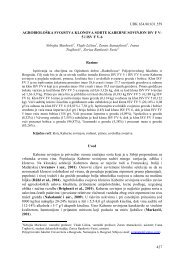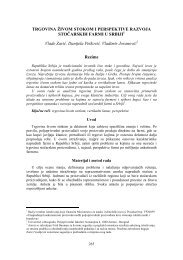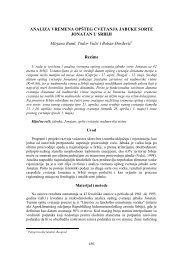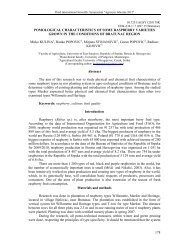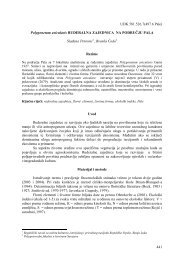405 BIOLOGICAL PRODUCTIVITY OF VERTISOL CULTIVATED ...
405 BIOLOGICAL PRODUCTIVITY OF VERTISOL CULTIVATED ...
405 BIOLOGICAL PRODUCTIVITY OF VERTISOL CULTIVATED ...
Create successful ePaper yourself
Turn your PDF publications into a flip-book with our unique Google optimized e-Paper software.
Third International Scientific Symposium "Agrosym Jahorina 2012"<br />
10.7251/AGSY1203<strong>405</strong>M<br />
UDK 631.816.3<br />
<strong>BIOLOGICAL</strong> <strong>PRODUCTIVITY</strong> <strong>OF</strong> <strong>VERTISOL</strong> <strong>CULTIVATED</strong> WITH FIELD PEA<br />
UNDER NITROGEN FERTILIZATION CONDITIONS<br />
Leka MANDIC 1* , Dragutin DJUKIC 1 , Snezana ANDJELKOVIC 2 , Aleksandra<br />
STANOJKOVIC 3 , Ivana BOSKOVIC 4<br />
1 University of Kragujevac, Faculty of Agronomy, Cacak, Serbia,<br />
2 Forage Crops Research Institute, Kruševac, Serbia<br />
3 Institute of Soil Science, Belgrade, Serbia<br />
4 Faculty of Agriculture, University of East Sarajevo, Republic of Srpska, Bosnia and Herzegovina<br />
(Corresponding author: lekamg@tfc.kg.ac.rs)<br />
Abstract<br />
This study evaluates the effect of different rates of mineral nitrogen fertilizer on<br />
ammonifier counts, protease activity and some chemical characteristics of vertisol (pH,<br />
phosphorus and potassium levels) under field pea cultivation. Increasing rates of mineral<br />
nitrogen fertilizers (20, 40 and 60 kg ha -1 ) combined with standard rates of phosphorus and<br />
potassium (75 and 60 kg ha -1 , respectively) were incorporated prior to seeding, with their<br />
effect on the above biological parameters being monitored during two stages of field pea<br />
development (pod formation and wax-ripe stage), and their effect on soil chemical<br />
characteristics after field pea harvest. The results show that the use of these fertilizers led to a<br />
significant decrease in ammonifier counts in the first stage of the study (particularly the 60 kg<br />
ha -1 rate), and a non-significant effect in the wax-ripe stage. Conversely, protease activity was<br />
significantly increased by lower fertilization rates (20 and 40 kg ha -1 ) during the first period of<br />
the study, and by all three nitrogen fertilization rates at the milk-wax ripeness stage. The use<br />
of these fertilizers did not affect soil pH, unlike readily available phosphorus and potassium<br />
levels.<br />
Keywords: ammonifiers, nitrogen fertilizers, proteolytic activity, vertisol, field pea.<br />
Introduction<br />
As a legume having a marked ability to establish an effective symbiosis with active<br />
nitrogen-fixing bacterial strains, field pea does not require significant amounts of mineral<br />
nitrogen fertilizers for its growth and development (Đukić et al., 2009). However, this fact is<br />
often neglected in intensive production systems which use inadequate (higher) rates of these<br />
fertilizers, thereby risking having unfavourable physicochemical and biological characteristics<br />
of the soil and, eventually, crop yield and quality. Therefore, the judicious efficient use of<br />
mineral fertilizers (notably nitrogen fertilizers, in these plants) can be possible only if a<br />
complex approach involving microbiological research is adopted. The importance of<br />
microbiological research lies in the fact that microorganisms, as the most active component of<br />
biogeocenosis in biogeochemical terms, are a vital factor of soil biological productivity,<br />
environmental status and quality of crop production (Milošević et al., 2004; Essah and<br />
Delgado, 2009). Moreover, the count and activity of soil microorganisms can serve as an<br />
indication of the economic justifiability of the use of different types, combinations and rates<br />
of fertilizers (Černy et al., 2003; Stark et al., 2007). As a rule, mineral fertilization, used as a<br />
radical method for improving soil nutrient balance, intensifies microbial processes (Fauci and<br />
Dick, 1994). However, long-term fertilization, particularly with high rates of nitrogen<br />
<strong>405</strong>
Third International Scientific Symposium "Agrosym Jahorina 2012"<br />
fertilizers, can have deleterious effects, leading to increased gaseous nitrogen losses,<br />
deteriorated physicochemical and biological properties of the soil and, eventually, diminished<br />
safety of the crop produced (Barabasz et al., 2002; Ayoola and Adeniyan, 2006). This is<br />
particularly the case under long-term fertilization which results in failure to obtain expected<br />
crop yields. The dual nature of mineral fertilizers, once they provide nutrient supply to the<br />
plant, allows them to ensure yield increases, while at the same time deteriorating soil<br />
properties and acting as a hidden cause of soil degradation (Mandić et al., 2004). Changes in<br />
the count of certain groups of soil microorganisms under the effect of different types of<br />
mineral fertilizers suggest their justifiable use as an indicator of soil fertility and crop yield<br />
(Đukić and Mandić, 2000). Hole et al. (2005) showed that a change in microbial biomass is a<br />
parameter that provides a clearer faster response to the incorporation of mineral fertilizers into<br />
the soil, which eventually affects its potential and effective productivity.<br />
The objective of this study was to evaluate the effect of different rates of mineral<br />
nitrogen and constant rates of phosphorus and potassium on ammonifier counts, protease<br />
activity and some chemical characteristics of vertisol under field pea cultivation.<br />
Material and methods<br />
The experiment was carried out at the Faculty of Agronomy in Čačak (2006) on vertisol<br />
(acid in reaction - pH KCl 5.01, having a moderate supply of humus - 2.68% and nitrogen -<br />
0.134%, a good supply of readily available potassium - 0.264 mg g -1 and a low supply of readily<br />
available phosphorus - 0.029 mg g -1 ), in a randomized block design in four replications. The<br />
study involved the following treatments (factor A): unfertilized control; N 1 PK (20: 75: 60 kg ha -<br />
1 ); N 2 PK (40:75:60 kg ha -1 ) and N 3 PK (60: 75: 60 kg ha -1 ). The fertilizers were applied before<br />
sowing in the form of urea (nitrogen fertilizer), superphosphate (phosphorus fertilizer) and KCl<br />
(potassium fertilizer). The experimental plot was 10 m 2 in size, with a spacing of 0.5 m between<br />
plots. Field pea cv. Junior was sown by a mechanical seed drill at a rate of 40 kg ha -1 . During<br />
the growing season, common crop care practices were employed, including chemical weed<br />
control and mechanical preparation of the soil between the plots. Soil samples were collected<br />
for microbiological analysis aseptically up to 25 cm depth during two periods of field pea<br />
development (factor B): period I: onset of pod formation; period II – full wax ripeness.<br />
Microbiological analyses involved determination of ammonifier counts, by the indirect<br />
method of growth on MPA medium (Pochon and Tardieux, 1962), and protease activity<br />
(Romejko, 1969). Soil chemical analysis, across treatments, was carried out after harvest,<br />
involving determination of readily available phosphorus and potassium using the Egner Riehm<br />
AL method (P 2 O 5 – spectrophotometry, K 2 O – flame photometry and pH (potentiometric<br />
method).<br />
The results obtained were subjected to a two-factor analysis of variance (fertilization,<br />
growing season). Testing of the significance of differences was performed by LSD test (Statistica<br />
SPSS 5).<br />
Results and discussion<br />
The analysis of variance of ammonifier counts suggests a significant effect of nitrogen<br />
fertilizers and growing season on the presence of this physiological group of microorganisms.<br />
The results obtained show that all nitrogen application rates, excepting the lowest rate (20<br />
kg ha -1 ), induced a decrease in ammonifier count during the first period of the study (Table 1),<br />
with the most depressive effect being observed in the treatment with 60 kg ha -1 .<br />
This effect is often associated with changes in soil physicochemical characteristics (Stark<br />
et al., 2007) or, more likely in this case, alterations in the structure of soil microbial cenosis<br />
406
Third International Scientific Symposium "Agrosym Jahorina 2012"<br />
expressed through the predominance of toxinogenic and phytopathogenic fungi, as induced by<br />
excess nitrogen remaining unused by the plant. Their predominance, along with the increase in<br />
ammonifier count, can cause a decline in the count of Gram-negative bacteria, in particular, and<br />
other poorly competing types of soil microorganisms (Barabasz et al., 2002). The same authors<br />
underline that inadequate nitrogen fertilization can result in the production of toxic metabolites<br />
(nitrosamines, nitrosamides, etc.) which can, apart from their depressing effect on most soil<br />
microorganisms, cause teratogenic, carcinogenic and allergic effects in higher organisms (plants,<br />
animals and humans) through the food chain. A somewhat lower depressive effect of nitrogen<br />
fertilizers at the first stage of the study was observed in treatments with 40 kg ha -1 . During the<br />
second period of the study, the three nitrogen rates had a non-significant effect on ammonifier<br />
count. This can be attributed to the decrease in free nitrogen levels in the soil and, hence, their<br />
lower impact on this group of microorganisms in the final vegetation stages of field pea<br />
development (Đukić, 1984).<br />
Overall, the significantly lower count of ammonifiers in the second sampling period can<br />
be due to the effect of environmental factors (low soil moisture and high temperature) and reduced<br />
root metabolism of the crop (Bolton et al., 1992).<br />
Table 1. Average ammonifier count in the soil (10 6 g -1 absolutely dry soil) and protease activity<br />
(number of gelatine-like units g -1 air-dry soil) as dependent upon the fertilizers used<br />
Ammonifier count Proteolytic activity<br />
Fertilization (A)<br />
Control 40,7 a 34,83 b<br />
N 1 PK 39,7 ab 58,75 a<br />
N 2 PK 35,0 b 57,50 a<br />
N 3 PK 21,0c 55,3 a<br />
Periods (B)<br />
I 65,3 a 44.87 b<br />
II 2,63 b 57,92 a<br />
Control I 78,0 a 41,5 de<br />
II 3,5 d 26,7 f<br />
N 1 PK I 76,5 a 45,0 cd<br />
II 3,0 d 72,5 a<br />
N 2 PK I 68,0 b 47,5 b<br />
II 2,0 d 67,5 b<br />
N 3 PK I 40,0 c 45,5 c<br />
II 2.0 d 65,0 b<br />
Anova<br />
A ** **<br />
B ** **<br />
AB ** **<br />
Values followed by different small letters within columns are significantly different (P≥0.05) according to LSD test<br />
As opposed to ammonifiers, soil protease activity was significantly increased by mineral<br />
fertilization (Table 1), primarily by lower nitrogen application rates (20 and 40 kg ha -1 ) in the first<br />
and most notably in the second period of the study. The higher nitrogen rate (60 kg ha -1 ) is not<br />
economically justified, since it did not have a significant effect on the activity of proteolytic<br />
enzymes, as compared to the lower nitrogen rates. Similar results were reported by other authors<br />
who stressed the positive effect of lower rates of mineral fertilizers on most soil hydrolytic<br />
enzymes (Sarić et al., 1986, Blecharczyk et al., 1993, Koper and Piotrowska, 2003).<br />
407
Third International Scientific Symposium "Agrosym Jahorina 2012"<br />
In all treatments, excepting the untreated control, protease activity was higher in the second<br />
period of the study, showing an opposite tendency relative to the count of ammonifiers. This finding<br />
complies with the results of other authors who found that soil protease activity is dependent more<br />
upon the metabolic activity of the root than upon weather factors during the plant growing season<br />
(Kandeler et al., 1999).<br />
The test fertilizers also had an effect, although somewhat lower, on soil chemical<br />
characteristics (Table 2).<br />
Table 2. Major chemical characteristics of vertisol as dependent upon mineral fertilizer after field pea<br />
harvest<br />
pH (nKCl) P 2 O 5 (mg g -1 soil) K 2 O (mg g -1 soil)<br />
Control 4.97 0.018 0.267<br />
N 1 PK 4.88 0.019 0.293<br />
N 2 PK 5.00 0.028 0.299<br />
N 3 PK 4.94 0.025 0.268<br />
The smallest changes were observed in soil pH. The lower values for readily available<br />
phosphorus, recorded after pea harvest in the untreated control and in the treatments with the<br />
lowest nitrogen fertilizer rate, suggest marked plant requirements for this nutrient as well as<br />
its removal from the soil by the crop. Similar results were obtained by other authors (Ćirović<br />
and Jocić, 1992, Bošković, 1993). Higher nitrogen rates incorporated into the soil (N 2 and N 3 )<br />
can largely prevent the uptake of phosphorus by the crop, which can result in higher levels of<br />
phosphorus in these treatments as compared to the untreated control and treatment with the<br />
lowest nitrogen rate. Higher nitrogen rates had a similar effect on the level of readily available<br />
phosphorus in the soil. Since substantial changes in soil chemical characteristics can be<br />
expected only after the long-term use of mineral fertilizers (Lebedeva and Zagumennikov,<br />
1977, Jelić, 1997), the changes observed in this study can be considered fully expected.<br />
Conclusion<br />
The nitrogen fertilizers used for field pea production induced a change in the count of<br />
ammonifiers and protease activity, whereas their effect on soil chemical parameters was<br />
lower.<br />
The decline in ammonifier count was observed in the initial stage of pod formation in<br />
treatments with 40 and 60 kg ha -1 nitrogen, whereas their effect in the milk wax ripeness<br />
stage, in all fertilization treatments, was statistically non-significant. Overall, throughout the<br />
pea growing season, differences in ammonifier counts in the treatments with 20 kg ha -1 and 40<br />
kg ha -1 were statistically non-significant, whereas the count in the treatment with 60 kg ha -1<br />
was statistically significantly lower as compared to the two treatments and the control.<br />
In both periods of the study, soil protease activity was particularly stimulated by lower<br />
nitrogen fertilization rates (20 and 40 kg ha -1 N). The non-significant effect of the highest<br />
nitrogen rate (60 kg ha -1 ) on the activity of proteolytic enzymes as compared to the two lower<br />
rates suggests that the highest nitrogen rate is not economically justified in field pea<br />
production.<br />
The fertilizers applied did not have a significant effect on soil pH. However, all fertilizers,<br />
particularly the higher nitrogen rates, induced a certain increase in the levels of readily available<br />
phosphorus and potassium in the soil under field pea.<br />
408
Third International Scientific Symposium "Agrosym Jahorina 2012"<br />
Acknowledgement<br />
This study is part of the project “Improvement of the genetic potential of forage crops<br />
and production technologies towards the sustainable development of animal husbandry” – TR<br />
31057 funded by the Ministry of Education and Science, Republic of Serbia.<br />
References<br />
Ayoola O.T., Adeniyan O.N. (2006). Influence of poultry manure and NPK fertilizer on yield<br />
and yield components of crops under different cropping systems in south west Nigeria.<br />
Afr. J. Biotechnol., Vol. 5 (15), 1386-1392.<br />
Barabasz W., Albinska D., Jaskowska M., Lipiec J. (2002). Biological Effects of Mineral Nitrogen<br />
Fertilization on Soil Microorganisms. Pol. J. Environ., Vol.11, No. 3, 193-198.<br />
Blecharczyk A., Skrzypczak, G. Malecka I. (1993). Effect of long-term organic and mineral<br />
fertilization on chemical properties and enzymatic activity of soil. Long-term static<br />
fertilization experiments. Warszawa – Krakow, 167-176.<br />
Bolton H.Jr., Fredrickson J.K., Elliott L.F. (1992). Microbial ecology of the rhizosphere.<br />
Marcel Dekker Inc., New York.<br />
Bošković Lj. (1993). Đubrenje pšenice ureaformaldehidom i klasičnom ureom na<br />
različitim zemljištima. Magistarska teza, Agronomski fakultet, Čačak.<br />
Černy J., Balik J., Pavlikova D., Zitkova M., Sykora K. (2003). The influence of organic and<br />
mineral nitrogen fertilizers on microbial biomass nitrogen and extractable organic<br />
nitrogen in long-term experiments with maize. Plant Soil Environ., No.12, 560-564.<br />
Ćirović M., Jocić B. (1992). Uticaj primene minerahiih đubriva na prinos kukuruza.<br />
Savremena poljoprivreda, Vol. 40 (6), 61-69.<br />
Đukic D. (1984). Uticaj različitih doza i kombinacija NPK i stajnjaka na kvantitativnu<br />
zastupljenost proteolitskih mikroorganizama u černozemu pod pšenicom. Savremena<br />
poljoiprivreda, Vol. 32 (1-2), 67-73.<br />
Đukić D., Mandić L. (2000). Microorganisms and Technogenic Polution of Agroecosystem. Acta<br />
Agriculturae Serbica, Vol. 5 (10), 37-44.<br />
Đukić D., Stevović V., Janjić V. (2009). Stočni grašak – Pisum sativum ssp. arvense L. Proizvodnja<br />
stočne hrane na oranicama i travnjacima. Poljoprivredni fakultet N. Sad i Agronomski<br />
fakultet Čačak, 369-376.<br />
Essah S.Y.C., Delgado J.A. (2009). Nitrogen Management for Maximum Potato Yield, Tuber<br />
Quality, and Environmental Conservation. Appropriate Technologies for Environmental<br />
Protection in the Developing World, VI: 307-315.<br />
Fauci M.F., Dick R.P. (1994). Soil microbial dynamics: short and long term effect of inorganic<br />
and organic nitrogen. Soil Sci. Soc. Am. J., Vol. 58 (3), 801-806.<br />
Hole D.G., Perkins A.J., Wilson J.D., Alexander I.H., Grice P.V., Evans A.D. (2005). Does<br />
organic farming benefit biodiversity? Biol. Conserv., No. 122, 113-130.<br />
Jelić M., Lomović S., Milojević J. (1997). Proučavanje primene azotnih i fosfornih đubriva na<br />
promenu nekih hemijskih svojstava zemljišta tipa lesivirane smonice. IX Kongres<br />
Jugoslovenskog društva za proučavanje zemljišta, Novi Sad, 196-202.<br />
Kandeler E., Tscherko D., Spiegel. H. (1999). Long-term monitoring of microbial biomass,<br />
mineralization and enzyme activities of a chernozem under different tillage menagment.<br />
Biology ang Fertility of Soils, No. 28, 343-351.<br />
Koper J., Piotrowska A. (2003). Application of biochemical index to define soil fertility depending on<br />
varied organic and mineral fertilization. Electronic Journal of Polish Agricultural Universities,<br />
Vol.6 (1), online http://www.ejpau.media.pl/volume6/issue1/agronomy/art-06.html.<br />
Pristupljeno 17.9.2012.<br />
409
Third International Scientific Symposium "Agrosym Jahorina 2012"<br />
Lebedeva L.A., Zagumenniko, V.B. (1977). Vlijanije mineralnih udobrenij pri ih dlitelnom i<br />
odnokratnom primenenii na nitrificirujušuju sposobnost dernovo-podzolistoj počvi.<br />
Vest. Mosk. un-ta. Počvovedenie, No. l, 92-96.<br />
Mandić L., Đukić D., Stevović V. (2004). Brojnost zemljišnih gljiva i produktivnost silokrme<br />
kukuruza u uslovima primene različitih sistema đubrenja. Acta Agriculturae Serbica, Vol.<br />
IX (17) (spec. Issue), 211-220.<br />
Milosevic N., Govedarica M., Djukic D., Stanisavljevic R. (2004). Microbiological activity of<br />
soil under planted and natural grasslands. Acta Agriculturae Serbica, No. 17, 195-201.<br />
Pochon J., Tardieux P. (1962). Techniques d'analyse en microbiologie du sol. Edition de la<br />
Tourelle, Saint Mandé, INRA Press, Paris, 111 pp.<br />
Romejko I.N. (1969). Proteolitičeskaja aktivnost dernogo - podzolistoj počvi pri raznih<br />
sposobah vspaški. Počvovedenij, No. 10, 87-90.<br />
Sarić Z., Mrkovački N., Đukić D. (1986). Uticaj mineralnih đubriva na aktivnost nekih<br />
oksidoreduktaza i proteaze u černozemu. Zbornik abstrakata sa VII Kongresa biologa<br />
Jugoslavije, Budva, s. 82.<br />
Stark C., Condron L.M., Stewart A.D., Di H.J., O’Callaghan M. (2007). Influence of organic<br />
and mineral amendments on microbial soil properties and processes. Appl. Soil Ecol.<br />
No. 35, 73-93.<br />
StatSoft.Inc. (1995). STATISTICA for Windows (computer program manual). Tulsa. OK:<br />
StatSoft.Inc.<br />
410





